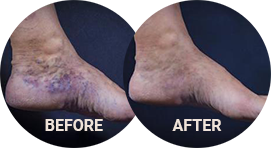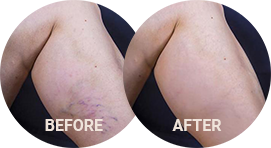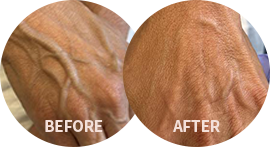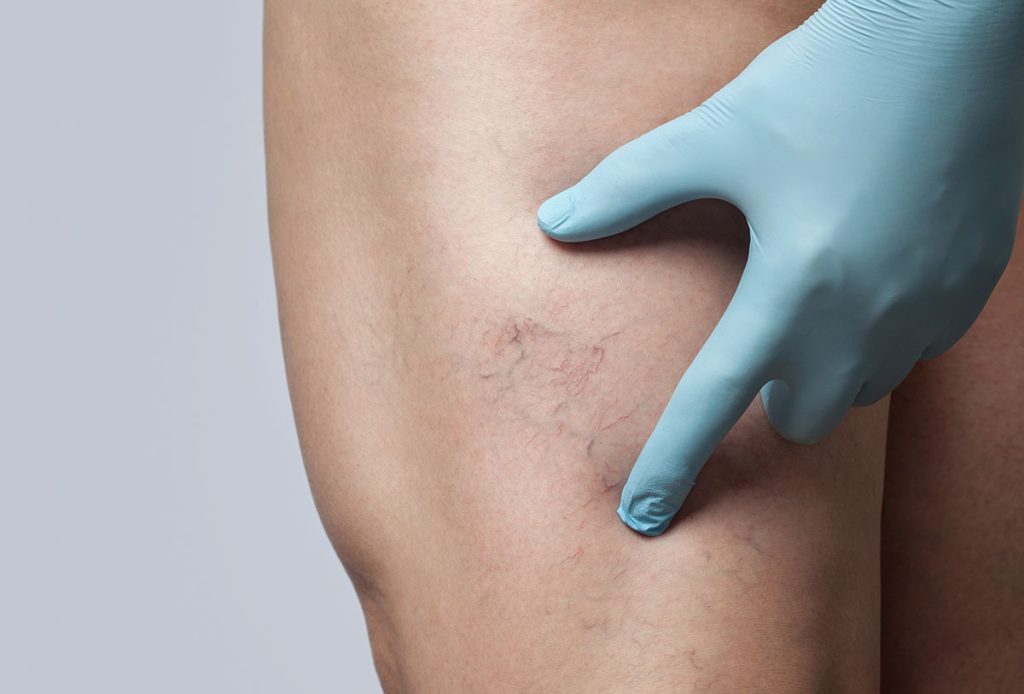Nicotine is a powerful stimulant that can have detrimental effects on the circulatory system. When it enters the bloodstream, it causes the blood vessels to constrict, leading to an increase in heart rate and blood pressure. This vasoconstriction makes it harder for blood to flow through the arteries, which can lead to reduced oxygen supply to the body’s tissues. Furthermore, nicotine can cause platelet aggregation, which means that blood cells clump together forming clots. These clots can clog up blood vessels, leading to complications such as stroke, heart attack, vein blood clots and peripheral artery disease.
In addition, nicotine can damage the endothelial cells lining the arterial and venous walls, leading to endothelial dysfunction. (1) Endothelial cells play a crucial role in maintaining healthy blood vessels, and when they are damaged, it can lead to inflammation, plaque buildup, and ultimately atherosclerosis (hardening of the arteries) and endophlebitis.
At Premier Vein Clinic, we specialize in treating circulatory system disorders such as varicose veins and spider veins. Board-certified vascular surgeon Dr. David Naar and our team advise patients to quit smoking and avoid all forms of nicotine to improve their overall vascular health. If you are experiencing any symptoms related to your circulatory system, please give us a call at (440) 641-0433 to schedule a consultation.
Contents
- 1 Before & After Photos
- 2 About Nicotine
- 3 Nicotine & Varicose Veins
- 4 Personal Consultation
- 5 Varicose Vein Treatments
- 6 Cost of Varicose Vein Treatment in Westlake, OH
- 7 FAQ
- 7.1 Can quitting smoking improve varicose veins?
- 7.2 What lifestyle changes can I make to improve my vein health and prevent varicose veins?
- 7.3 Are there any other risk factors for varicose veins besides nicotine use?
- 7.4 Can preventing varicose veins also help prevent other diseases?
- 7.5 Is it possible to reverse the damage caused by nicotine to the veins?
- 8 References
Before & After Photos
View More Photos
About Nicotine
Nicotine is a highly addictive substance found in tobacco products that can have a significant impact on the circulatory system, leading to adverse effects on cardiovascular health. The circulatory system is responsible for delivering oxygen and nutrients to all parts of the body, including the heart and blood vessels. Nicotine affects this system by causing vasoconstriction or narrowing of blood vessels, which can increase blood pressure and heart rate.
What Does Nicotine Do in the Body?
When nicotine enters the bloodstream, it does the following:
- Binds to receptors in the brain, releasing dopamine and other neurotransmitters that produce feelings of pleasure and reward.
- Triggers the release of stress hormones like adrenaline and noradrenaline, which constrict blood vessels and increase heart rate.
Over time, chronic nicotine use can cause damage to the lining of blood vessels, leading to atherosclerosis or plaque buildup, which can increase the risk of stroke and coronary artery disease.
Smoking is a leading cause of preventable death worldwide. (2) In addition to the health risks mentioned above, smoking has been linked to a range of other health problems, including lung cancer, oral cancer, and emphysema.
Nicotine & Varicose Veins
Studies indicate that 33% of the general population aged between 18 and 64 years have varicose veins. (3) Smoking and other forms of nicotine intake have been shown to damage the venous walls, making them weaker and more prone to varicose vein development. Nicotine also constricts blood vessels, increasing the pressure in the veins, exacerbating the problem. Additionally, smoking can cause inflammation in the veins, further contributing to the development of varicose veins.
By quitting smoking and improving your vascular health, you can reduce your risk of developing varicose veins and other related conditions. If you already suffer from varicose veins, it is crucial to seek treatment to address the underlying venous insufficiency that may be contributing to your symptoms.
Varicose Vein Symptoms
- Gnarled, Twisted Leg Veins
- Swollen Feet & Ankles
- Leg Cramps (Particularly at Night)
- Burning/Throbbing in the Legs
- Heavy Legs
- Itchy, Dry Skin in the Legs
- Skin Discoloration
Personal Consultation
At Premier Vein Clinic, we understand that nicotine addiction and varicose veins can be a difficult combination to manage. That’s why Dr. Naar offers personalized consultations to help patients navigate this complex issue.
During your consultation, Dr. Naar will first assess your medical history and discuss your cosmetic concerns, including any symptoms you may be experiencing related to your varicose veins. He will then examine the condition of your veins and assess the extent of the damage.
It cannot be overstated that one of the most important steps in managing varicose veins is to quit smoking. Dr. Naar can create a customized smoking cessation plan tailored to your needs, which may include nicotine replacement therapy or counseling for nicotine dependence.
Varicose Vein Treatments
In many cases, varicose vein symptoms can be improved with compression therapy, whereby a patient wears special compression garments on their legs. However, this may not be suitable for everyone. At Premier Vein Clinic, we offer a range of in-office treatments for varicose veins.
Sclerotherapy
Sclerotherapy is a minimally-invasive injection procedure that is used to treat varicose and spider veins. During the procedure, a sclerosing solution is injected directly into the affected vein. This solution irritates the lining of the vein, causing it to collapse and eventually disappear over time. Blood flow is then redirected to healthier veins, improving overall circulation.
After the injection, compression stockings are worn to help maintain pressure on the treated veins. Patients are encouraged to avoid strenuous activity for a few days after the procedure, but can typically return to work and normal activities right away.
Sclerotherapy is not only a functional treatment for varicose veins, but it can also be a cosmetic one. By eliminating unsightly veins, patients can feel more confident and comfortable in their appearance.
Ambulatory Phlebectomy
Ambulatory phlebectomy is another minimally-invasive procedure that is used to treat varicose veins. Unlike vein stripping, which was once the primary treatment method for varicose veins, ambulatory phlebectomy is an outpatient surgery that requires only local anesthesia. This means that patients can return home on the same day of the procedure without any lengthy recovery periods.
Radiofrequency Venous Ablation
Radiofrequency endovenous ablation (RFA) is a procedure that uses thermal (radiofrequency or RF) energy delivered via a catheter to close off the affected vein, redirecting blood flow to surrounding veins.
The RFA procedure is performed under local anesthesia on an outpatient basis. A needle puncture or small incision is made in the skin near the affected vein, and a catheter is inserted into the vein. The catheter delivers thermal energy to the vein wall, causing it to contract and seal shut. Once the vein is closed, blood flow is redirected to healthier veins, reducing the appearance of varicose veins and improving overall circulation.
Endovenous Chemical Foam Ablation
Endovenous chemical foam ablation is a state-of-the-art medical procedure used to treat varicose veins and venous insufficiency. This minimally invasive technique involves the injection of a special foam solution directly into the affected vein, causing it to collapse and close off. The procedure is performed under ultrasound guidance by a highly skilled vascular surgeon, such as Dr. Naar.
This procedure is commonly used to treat the saphenous vein, which runs from the groin area down to the ankle. During endovenous chemical foam ablation, the vein collapses and seals shut. Over time, the body absorbs the closed vein, rerouting blood flow to healthier veins. This results in a significant reduction in symptoms such as swelling, pain, and unsightly bulging veins.
Cost of Varicose Vein Treatment in Westlake, OH
The cost of your treatment at Premier Vein Clinic will depend on the severity of your varicose veins and your chosen treatment plan. For more information about nicotine and the circulatory system, smoking cessation, and varicose vein treatment, call (440) 641-0433 or complete an inquiry form on our website to book a personal consultation with experienced vascular surgeon Dr. David Naar.
FAQ
Can quitting smoking improve varicose veins?
Yes, quitting smoking can improve the health of your veins and aid in preventing or reducing the severity of varicose veins. Nicotine damages the cardiovascular system, which includes the veins, and quitting smoking can help reduce the risk of further vein damage.
What lifestyle changes can I make to improve my vein health and prevent varicose veins?
Making healthy lifestyle choices such as exercising regularly, maintaining a healthy weight, avoiding prolonged periods of sitting or standing, and wearing compression stockings can aid in improving vein health and preventing varicose veins from developing or worsening.
Are there any other risk factors for varicose veins besides nicotine use?
Yes, there are several risk factors for varicose veins, including age, gender, family history, pregnancy, obesity, and a sedentary lifestyle. It’s important to be aware of these risk factors and take steps to prevent the development or worsening of varicose veins.
Can preventing varicose veins also help prevent other diseases?
Yes, maintaining good vein health and blood circulation can help prevent other cardiovascular diseases such as deep vein thrombosis (DVT) and peripheral artery disease (PAD). Making healthy lifestyle choices and seeking medical treatment when necessary can aid in overall disease prevention.
Is it possible to reverse the damage caused by nicotine to the veins?
While the damage caused by nicotine use cannot be completely reversed, quitting smoking and making healthy lifestyle changes can help prevent further damage and improve vein health. Seeking medical treatment for varicose veins can also aid in reducing symptoms and preventing complications.
References
- Li J, Liu S, Cao G, et al. Nicotine induces endothelial dysfunction and promotes atherosclerosis via GTPCH1. Journal of Cellular and Molecular Medicine. 2018;22(11):5406-5417. doi:https://doi.org/10.1111/jcmm.13812
- Benowitz NL, Burbank AD. Cardiovascular Toxicity of Nicotine: Implications for Electronic Cigarette Use. Trends in Cardiovascular Medicine. 2016;26(6):515-523. doi:https://doi.org/10.1016/j.tcm.2016.03.001
- Aslam MR, Muhammad Asif H, Ahmad K, et al. Global impact and contributing factors in varicose vein disease development. SAGE Open Medicine. 2022;10:205031212211189. doi:https://doi.org/10.1177/20503121221118992





